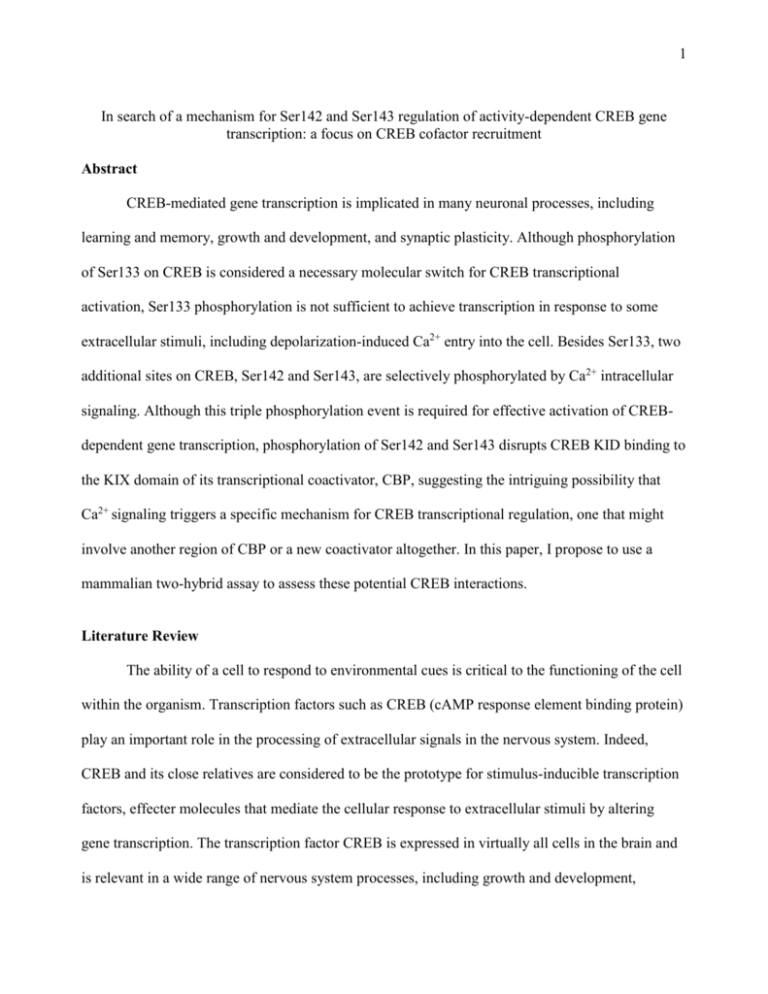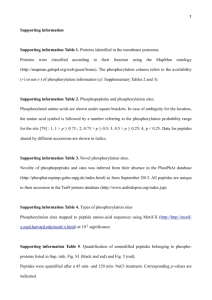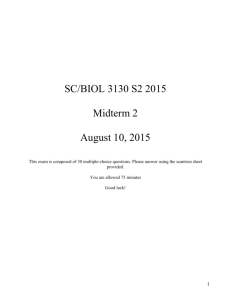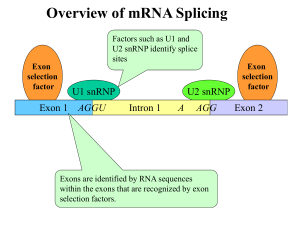Phuong Hoang
advertisement

1 In search of a mechanism for Ser142 and Ser143 regulation of activity-dependent CREB gene transcription: a focus on CREB cofactor recruitment Abstract CREB-mediated gene transcription is implicated in many neuronal processes, including learning and memory, growth and development, and synaptic plasticity. Although phosphorylation of Ser133 on CREB is considered a necessary molecular switch for CREB transcriptional activation, Ser133 phosphorylation is not sufficient to achieve transcription in response to some extracellular stimuli, including depolarization-induced Ca2+ entry into the cell. Besides Ser133, two additional sites on CREB, Ser142 and Ser143, are selectively phosphorylated by Ca2+ intracellular signaling. Although this triple phosphorylation event is required for effective activation of CREBdependent gene transcription, phosphorylation of Ser142 and Ser143 disrupts CREB KID binding to the KIX domain of its transcriptional coactivator, CBP, suggesting the intriguing possibility that Ca2+ signaling triggers a specific mechanism for CREB transcriptional regulation, one that might involve another region of CBP or a new coactivator altogether. In this paper, I propose to use a mammalian two-hybrid assay to assess these potential CREB interactions. Literature Review The ability of a cell to respond to environmental cues is critical to the functioning of the cell within the organism. Transcription factors such as CREB (cAMP response element binding protein) play an important role in the processing of extracellular signals in the nervous system. Indeed, CREB and its close relatives are considered to be the prototype for stimulus-inducible transcription factors, effecter molecules that mediate the cellular response to extracellular stimuli by altering gene transcription. The transcription factor CREB is expressed in virtually all cells in the brain and is relevant in a wide range of nervous system processes, including growth and development, 2 learning and memory, circadian entrainment, and addiction (Carlezon et al., 2005; Lonze and Ginty, 2002). Given that CREB-mediated gene transcription underlies so many functions of the nervous system, it is important to understand how CREB is regulated in the brain. CREB is a member of the bZIP superfamily of transcription factors, containing a C-terminal basic domain that mediates DNA binding, and a leucine zipper domain that promotes dimerization. CREB can form homo- and hetero- dimers with itself or other members of the CREB family and bind to the cis-regulatory element, cAMP response element (CRE). Since CRE sites are often found within the regulatory (promoter or enhancer) regions of genes, CREB binding can alter the transcription of genes (Lonze and Ginty, 2002). CREB-mediated gene transcription is activated in response to diverse extracellular stimuli (including growth factors, depolarization and synaptic activity of neurons, and stress responses). These external inputs to the cellular membrane trigger multiple intracellular signaling pathways, such as those involving cAMP and cAMP-dependent protein kinase (PKA), and Ca2+ and its associated kinases (Carlezon et al., 2005). The convergence of these intracellular pathways results in the phosphorylation of Serine133 within the kinaseinducible domain (KID) on both members of the CREB dimer (Lonze and Ginty, 2002). Indeed, Ser133 has been identified as the key regulatory site for CREB activation, its phosphorylation serving as a necessary molecular switch for CREB activation (Yamamoto et al., 1988). Activated CREB then recruits its coactivators, CREB binding protein (CBP) and p300 (whose functions are considered interchangeable), leading to the formation of a transcriptional complex that promotes histone acetylation of nearby chromatin and RNA synthesis by RNA polymerase II (Carlezon et al., 2005; Impey et al., 2002). Although the prevailing view of CREB activation highlights phosphorylation of Ser133 as the necessary molecular switch for CREB-mediated gene expression, phosphorylation of Ser133 may not be sufficient to activate gene transcription under some circumstances. For example, Mayr 3 et al. (2001) reported that although Ser133 phosphorylation on CREB is sufficient to activate CREB-dependent gene transcription in response to cAMP signals, it is not sufficient to activate CREB gene transcription in response to non-cAMP signals such as neurotrophic growth factor (NGF), mitogen- and stress-activated protein kinase 1 (MSK1), or calcium/calmodulin-dependent protein kinases II and IV (CaKMII and CaKMIV), even though these signaling pathways were found to be capable of phosphorylating Ser133 on CREB. Several hypotheses currently exist to explain why Ser133 phosphorylation may not be sufficient to activate gene transcription, including that phosphorylation at Ser133 is not enough to recruit CBP to CREB for gene transcription under certain circumstances, and that CBP may require additional modification to be activated (Sun and Maurer, 1995; Impey et al., 2002). It has also been suggested that CREB-mediated gene transcription may require additional modification events at CREB sites other than Ser133 (Parker et al., 1998). In this paper, I will focus on this latter hypothesis, which has been the subject of several fairly recent studies on CREB regulation in the nervous system (Kornhauser et al., 2002; Gau et al., 2002). It should be noted, however, that these hypotheses are not necessarily mutually exclusive, nor are they the only possible explanations of what might be happening in the cell. It is instead very likely that CREB activation and regulation involves complex and dynamic processes not yet well understood. In a paper published in 1994, Sun et al. found that CaMKIV phosphorylates CREB at Ser133 only, whereas CaMKII phosphorylates CREB at Ser133, as well as at a second site, Ser142, also within the transcriptional activation domain (KID) of CREB. Furthermore, they found that concurrent stimulation of Ser133 and Ser142 by CaMKII failed to stimulate CREB activity, while mutation of Ser142 to alanine enhanced CREB-dependent gene transcription, suggesting that phosphorylation of Ser142 may serve as a negative regulator of CREB activation, at least when Ca2+ signaling is involved. More recently, Gau et al. (2002) showed that phosphorylation of Ser142 (as 4 well as Ser133) is required for the entrainment of the circadian clock in mice, implicating phosphorylation of Ser142 in the transcriptional regulation of CREB. Interestingly, Gau et al.’s in vivo results contrast with the in vitro findings of Sun et al. (1994), which suggested that phosphorylation of CREB at Ser142 inhibited CREB-dependent gene transcription. Although not enough research has been done to reconcile these seemingly contradictory findings, the results clearly point to the modulatory role of Ser142 phosphorylation on CREB activity when the cell is stimulated by Ca2+ influx. Besides Ser142, phosphorylation of Ser143 (also within the CREB KID) has also been suggested to play a regulatory role in CREB-mediated gene transcription. Parker et al. (1998) identified Ser142 and Ser143 as sites of phosphorylation by casein kinase II (CKII), a kinase induced by Ca2+ signaling. Recently, Michael Greenberg’s group found that when Ca2+-signalinginduced phosphorylation of Ser142 and Ser143 occurred together with Ser133 phosphorylation, CREB-mediated gene transcription was enhanced, whereas mutation of Ser142 and Ser143 to alanines reduced CREB-dependent transcription (Kornhauser et al., 2002). Moreover, stimulation of CREB gene transcription by cAMP/PKA or neurotrophin signaling pathways did not produce the same results, as only phospho-Ser133 was generated via these signaling pathways. It appears then as though Ca2+ signaling produces a specific regulatory mechanism for CREB-dependent transcriptional activation, suggesting that depolarization and synaptic activity trigger a CREBmediated transcriptional response that is distinct from the response to other types of extracellular stimuli. In other words, in the presence of depolarization-induced Ca2+ entry, CREB-mediated gene transcription may be regulated (e.g., enhanced or inhibited) by phosphorylation of Ser142 and Ser143, whereas CREB activation and transcription may be unaffected by phosphorylation of these additional serine residues when Ca2+ signaling is not involved. 5 Perhaps even more interesting than the fact that Ca2+ signaling may have a distinct regulatory effect on CREB-mediated gene transcription is the finding that phosphorylation of Ser142 and Ser143 disrupts CREB KID binding to the KIX domain of the CREB coactivator CBP (Parker et al., 1998; Kornhauser et al., 2002). Normally, Ser133 phosphorylation of CREB within the KID promotes gene transcription via complex formation with the KIX domain of CBP (Chrivia et al., 1993). Whereas phosphorylation at Ser133 stabilizes the KID:KIX complex, Parker et al. (1998) found that concurrent phosphorylation at Ser142 blocks formation of the KID:KIX complex by disrupting important secondary structure-mediated interactions between CREB and CBP. However, these results conflict with the results from a study published by Sun and Maurer (1995), which reported that substitution of Ser142 with the amino acid aspartame (to mimic phosphorylation) at this site did not result in interference with KID:KIX binding. To get at this problem, Kornhauser et al. (2002) employed an in vitro GST pull down-assay to find that although Ser133 phosphorylation promotes interaction of the CREB KID to CBP KIX, when Ser142 and Ser143 were phosphorylated concurrently with Ser133, CREB was unable to bind with the KIX domain. This result shows that Ser142 and Ser143 phosphorylation disrupt Ser133phosphorylation-dependent CREB interaction with CBP KIX. In order to determine whether phosphorylation of Ser142, Ser143, or both residues is required to disrupt CREB-CBP KIX interaction, the investigators used versions of CREB in which Ser142 and/or Ser143 were mutated to alanine, and therefore unable to be phosphorylated. They found that when CREB Ser142 and/or Ser143 were mutated to alanine and CREB was phosphorylated by both PKA and CKII, CREB was incapable of binding to CBP KIX. However, when Ser142 and/or Ser143 were mutated to alanine, and CREB was phosphorylated with PKA only (so that only phospho-Ser133 was produced), additional phosphorylation by CKII no longer effectively disrupted the CREB-KIX interaction, indicating that phosphorylation of CREB at both Ser142 and Ser143 is required to effectively 6 disrupt Ser133-phosphorylation-dependent KID:KIX interaction. However, binding affinities of Ser142 and Ser143 were not established, and therefore it is still a possibility that phosphorylation of either Ser142 or Ser143 by itself can effectively disrupt the KID:KIX interaction. Nevertheless, this study seems to further indicate that Ser142 and Ser143 phosphorylation play an important role in how CREB-dependent transcription is activated when Ca2+ signaling is involved. The findings of Kornhauser et al., as well as Parker et al. in 1998, raise a very interesting possibility about CREB regulation: some CREB-dependent genes may be expressed entirely independently of CBP, or at least independent of a direct KID:KIX interaction. In other words, phosphorylation of Ser142 and/or Ser143 may mediate CREB-dependent gene transcription independently of the CBP KIX domain by recruiting a different domain of CBP to bind to CREB in order to initiate gene transcription or by recruiting an entirely different coactivator to CREB, one that has not yet been identified. Certainly these are compelling prospects, potentially adding further layers of complexity to our understanding of how CREB-mediated gene transcription is activated and regulated. Furthermore, if a novel CBP domain or coactivator is in fact recruited to CREB in response to Ca2+-induced Ser142 and Ser143 phosphorylation, it suggests that synaptic activity may induce CREB transcriptional activation via a specific mechanism that is sufficiently distinct from the traditional model of CREB activation. At the very least, this suggestion indicates the very likely possibility of context-specific regulation of CREB-mediated gene transcription, as has already been implied by Mayr et al. (2001). In the bigger picture, this context-specific regulation of CREB activity may help to elucidate how the nervous system selectively responds to its environment. Since CREB-mediated gene transcription is implicated in so many neuronal processes, this may ultimately affect our overall understanding of nervous system function. 7 Experimental Proposal Specific aim To determine if another domain of CBP or another unidentified cofactor is involved in Ser142 and Ser143 regulation of activity-dependent CREB transcriptional activation. Proposed Experiments Following the experimental protocol used by Kornhauser et al. (2002), I will culture cortical neurons extracted from mouse brains. Cultures will be membrane-depolarized by addition of KCl and CaCl2, inducing Ca2+ entry into the cell to stimulate Ser142, Ser143, and Ser133 phosphorylation on CREB by Ca2+-dependent kinases. I will use the mammalian two-hybrid assay to (1) identify potential non-KIX binding domains on CBP that interact CREB and (2) identify potential non-CBP cofactors that interact with CREB. Although there are other methods to examine protein-protein interactions, I have chosen the mammalian two-hybrid over the yeast two-hybrid system because it will enable me to study interactions between mammalian proteins that may require post-translational modification or external stimulation not present in yeast, not unlike CREB or CBP (Lee and Lee, 2004). To accomplish my first goal – identifying non-KIX binding domains interacting with CREB – I will first create my “bait” fusion protein: CREB DNA fused to the DNA binding domain (DBD) of the yeast Gal4 transcription activator. This fusion protein (Gal4DB-CREB) will go into plasmid vector. To create my “prey” fusion protein, or the protein that will bind to the pCREB-Gal4-N construct, I will construct a vector containing a segment of CBP DNA with a mutant KIX domain fused to the transcriptional activation domain (TAD) of the VP16 protein of herpes simplex virus (VP16-CBP). In order to create the KIX mutant CBP, I’ve chosen to follow the technique devised by Kasper et al. (2002), which is to mutate three residues (Tyr650, Ala654, and Tyr658) within the KIX domain in order to disrupt KIX binding to CREB. This is so that I can more readily identify 8 other domains on CBP with which CREB can interact when Ser142 and Ser143 are phosphorylated during Ca2+ signaling. Those vectors that express these fusion proteins will be co-transfected into mouse cortical neurons along with a reporter vector containing the LacZ gene under the control of five consensus Gal4 binding sites (UAS). If the two fusion proteins interact (in this case, CBP binds to CREB without the assistance of the KIX domain), transcriptional activation will occur and there will be a significant increase in expression of the LacZ reporter, producing a blue color (Osman, 2004). Western blot analysis will be performed to confirm successful transfection of the plasmid vectors into neurons (Lee and Lee, 2004). In order to accomplish my second goal – to identify non-CBP cofactors interacting with CREB – I will again use the bait fusion protein Gal4DB-CREB. To construct my “prey” fusion protein, I will do a screen of the mouse brain cDNA library for potential interacting protein partners of CREB. In other words, I will make a library of fusions to the VP16-TAD, testing them in pairwise combinations with Gal4DB-CREB to select for protein-protein interactions that will activate transcription of the LacZ reporter gene (Miller and Stagljar, 2004). As a control, I will be transfecting some cortical neurons with vectors containing Gal4DBCREB and vectors of VP16-CBP containing a functioning KIX domain. These cortical neurons, however, will not be membrane depolarized; instead, they will be treated with forskolin, which increases intracellular cAMP signaling (Xu et al., 2001). If the bait fusion protein, Gal4DB-CREB, is constructed correctly, then we should expect to see LacZ expression because we know that CREB binds normally to the KIX domain of CBP when only Ser133 phosphorylation is regulating CREB activity (Kornhauser et al., 2002). Furthermore, as additional controls, I will be transfecting some cortical neurons (membrane depolarized to activate Ca2+ signaling) with “empty” vectors, containing only the Gal4-DBD or VP16-TAD without the fusion proteins. Hopefully in these experiments we will not see LacZ activation: LacZ expression would imply that our constructs were 9 nonspecifically activating transcription without any protein-protein interaction. Finally, as another control, it may be revealing to perform the same experiments on mouse suprachiasmatic nucleus (SCN) neurons, which were the cells of choice for Gau et al. (2002). It seems as though this would be an interesting way to explore whether cell type differences are relevant to Ser142 and Ser143 regulation of CREB:CBP binding, as Ser142 and Ser143 phosphorylation may not occur robustly in all cell types (Gau et al., 2002). A technique that sometimes accompanies two-hybrid assays is coimmunoprecipitation (CoIP) to verify protein-protein interactions in vivo. The basic assumption of a Co-IP assay is that if protein X interacts with protein Y, then they should precipitate together. Using an antibody specific to CREB (the target antigen), any interacting protein bound to the CREB protein will precipitate alongside CREB and can be captured on an agarose gel support. The interacting proteins will be analyzed by gel electrophoresis and Western blot to verify the identity of the CREB-associated protein (Miller and Stagljar, 2004). I plan to use the Co-IP assays to validate any positive proteinprotein interactions detected by the two-hybrid assays. Possible Outcomes and Interpretations Four possible scenarios that can result from these experiments: (1) Ser142 and Ser143 phosphorylation does not recruit a novel domain of CBP to bind to CREB nor does it recruit a novel cofactor to CREB for transcriptional activation; (2) phosphorylation of these residues recruits a novel domain of CBP to bind to CREB; (3) phosphorylation of these residues recruits a novel cofactor to CREB; or (4) phosphorylation of these residues recruits a novel domain of CBP and a novel cofactor to bind to CREB. The first case would suggest that perhaps Ser142 and Ser143 phosphorylation regulate CREB transcriptional activation in a manner entirely independent of cofactor recruitment. Another intriguing possibility is that CBP itself is being modified following membrane depolarization: perhaps phosphorylation of Ser142 and Ser143 induces a conformation 10 change in CBP that causes the actual inhibition of the KID:KIX interaction. Still another possibility is that CBP is bound to another protein during Ser142 and Ser143 phosphorylation, which causes KID:KIX inhibition. Future experiments could identify how CBP protein itself is altered by Ser142 and Ser143 phosphorylation. On the other hand, if indeed scenarios (2) or (3) (or both, as in scenario 4) are happening within the cell, the traditional view of CREB transcriptional activation (at least following depolarization) may have to undergo revision to include the new interacting binding domains and/or cofactors, and further experiments will need to be performed to characterize these new interactions and explain how they might influence gene transcription. Possible Pitfalls and Solutions Unfortunately, problems can arise with the two-hybrid approach. For example, false positives from the two-hybrid approach (such as can result when your fusion protein can activate LacZ transcription on its own by binding to the Gal4 sites) can be a problem and can be resolved by testing the fusion proteins in isolation (i.e., transfect only the Gal4-DBD into a cell containing the Gal4 binding sites fused to a reporter gene). False positives may also be reduced by the use of multiple reporter genes under the control of a similar promoter, as well as by repeated assays of positive interactions to check for consistency. Co-IP will be very useful to verify positive interactions. Though not described here, a FRET assay could also be useful as further validation. Finally, there is the possibility that by taking out CBP KIX binding to CREB, I may in fact be presenting the neuron with something that it is unfamiliar with. After all, Ser142 and Ser143 phosphorylation appear to be modulators of CREB activity, and are not as absolute as Ser133 regulation of CREB transcriptional activation. As well, the phospho-Ser142 and Ser143 state is transient and slow-acting compared to phospho-Ser133 (Kornhauser et al., 2002). Therefore, any results I may extract from these experiments must be taken with a grain of salt. Future experiments must take into careful consideration the stoichiometrics and kinetics of CREB phosphorylation. 11 References Carlezon, W.A., Jr., Duman, R.S., and Nestler, E.J. (2005). The many faces of CREB. Trends Neurosci, 28(8), 436-445. Gau, D., Lemberger, T., von Gall, C., Kretz, O., Le Minh, N., Gass, P., Schmid, W., Schibler, U., Korf, H., and Schutz, G. (2002). Phosphorylation of CREB Ser142 regulates light-induced phase shifts of the circadian clock. Neuron, 34, 245-253. Impey, S., Fong, A.L., Wang, Y., Cardinaux, J., Fass, D.M., Obrietan, K., Wayman, G.A., Storm, D.R., Soderline, T.R., and Goodman, R.H. (2002). Phosphorylation of CBP mediates transcriptional activation by neural activity and CaM Kinase IV. Neuron, 34, 235-244. Kasper, L.H., al Boussouar, F., Nev, P.A., Jackson, C.W., Rehg, J., van Deursen, J.M., and Brindle, P.K. (2002). A transcriptional-factor-binding surface of coactivator p300 is required for haematopoiesis. Nature, 419, 738-743. Kornhauser, J.M., Cowan, C.W., Shaywitz, A.J., Dolmetsch, R.E., Griffith, E.C., Hu, L.S., Haddad, C., Xia, Z., and Greenberg, M.E. (2002). CREB transcriptional activity in neurons is regulated by multiple, calcium-specific phosphorylation events. Neuron, 34, 221-223. Lee, J.W. and Lee, S. (2004). Mammalian two-hybrid assay for detecting protein-protein interactions in vivo. Methods Mol. Biol., 261, 327-336. Lonze, B.E. and Ginty, D.D. (2002). Function and regulation of CREB family transcription factors in the nervous system. Neuron 35, 605-623. Mayr, B.M., Canettieri, G., and Montminy, M.R. (2001). Distinct effects of cAMP and mitogenic signals on CREB-binding protein recruitment impart specificity to target gene activation via CREB. Proc. Natl. Acad. Sci., 98, 10936-10941. Miller, J. and Stagljar, I. (2004). Using the yeast two-hybrid system to identify interacting proteins. Methods Mol Biol., 261, 247-262. Osman, A. (2004). Yeast two-hybrid assay for studying protein-protein interactions. Methods Mol Biol., 270, 403-422. Parker, D., Jhala, U.S., Radhakrishnan, I., Yaffe, M.B., Reyes, C., Shulman, A.I., Cantley, L.C., Wright, P.E., and Montminy, M. (1998). Analysis of an activator: coactivator complex reveals an essential role for secondary structure in transcriptional activation. Mol. Cell, 2, 353-359. Sun, P. and Maurer, R.A.(1995). An inactivating point mutation demonstrates that interaction of cAMP reponse element binding protein (CREB) with the CREB binding protein is not sufficient for transcriptional activation. J. Biol. Chem., 270, 7041-7044. 12 Sun, P., Enslen, H., Myung, P.S., and Maurer, R.A. (1994). Differential activation of CREB by Ca2+/calmodulin-dependent protein kinases type II and type IV involves phosphorylation of a site that negatively regulates activity. Genes & Dev, 8, 2527-2539. Xu, W., Chen, H., Du, K., Asahara, H., Tini, M., Emerson, B.M., Montminy, M., and Evan, R.M. (2001). Science, 294, 2507-2511. Yamamato, K.K., Gonzalez, G.A., Biggs, W.H., 3rd, and Montminy, M.R. (1988). Phosphorylationinduced binding and transcriptional efficacy of nuclear factor CREB. Nature, 334, 494-498.








